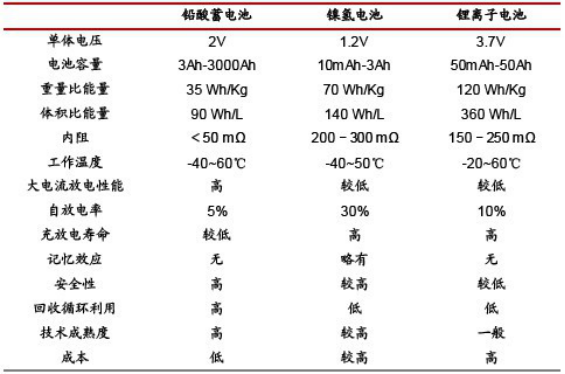The lead-acid battery invented by Plante since 1859 since, has 150 years of history, technology is mature, good safety performance, wide application range, but the volume ratio, energy / weight ratio of nickel metal hydride batteries, higher lithium ion batteries and other new two batteries, produced a certain threat to the dominance of the lead-acid storage battery the market worried about two times with the new battery technology is mature, continue to reduce costs, will produce a strong substitution effect of lead-acid battery. It is predicted that the field of vehicle initiation will not be replaced in the short run. Reserve and battery can be replaced only in small and medium capacity market. The field of power battery is most likely to be replaced by lithium ion battery, and its replacement process depends on the cost of lithium ion battery.
To compare the performance characteristics of lead-acid batteries, lithium-ion batteries, nickel metal hydride, nickel cadmium battery, you can see the lead-acid battery with high capacity, wide temperature range, high current discharge performance, low self discharge rate, good safety performance, mature technology, low cost, can be used circularly the advantages, but the volume ratio and weight ratio of energy low voltage low monomer. The most promising lithium ion battery in the market prospect is high volume ratio, high specific energy and high monomer voltage, but there are some problems such as small battery capacity, low current discharge performance, immature technology, outstanding safety problems, high cost and no recycling.
Table 1: comparison of the performance characteristics of three mainstream two times batteries

The different performance characteristics of two battery determines their application fields, which is suitable for starting batteries, lead-acid battery backup power supply, power storage and low-speed electric vehicles, lithium ion battery, due to its lightweight characteristics more suitable for portable equipment battery, high speed electric vehicle battery.
Starting batteries, lead-acid batteries are the most difficult to be solid, lithium ion batteries and other batteries instead of starting battery on the starting rate and cold start capability is high, the car starting battery starting rate of not less than 5-6 times, the motorcycle is not less than 8-10 times, lead battery internal resistance is small, instantaneous large current discharge performance well, the internal resistance of lithium ion battery, Ni MH battery, it is difficult to meet the requirements of the starting rate. In addition, the internal resistance of the battery is affected by temperature. The temperature drop will increase the internal resistance and reduce the large current discharge capacity of the battery. The normal working temperature range of the lead-acid battery is at -40 C -60 C, which is better than that of Li ion battery and Ni MH battery. Taking into account the lead-acid battery has the advantages of low cost, so the global starter battery is lead-acid battery, battery materials in future unless there is a new breakthrough, reduce the internal resistance of the lithium ion battery or battery, or starting lead-acid storage battery are difficult to replace other types of batteries.
Backup power, storage battery, lead-acid battery dominant, lithium battery can only enter the small capacity market: backup power supply, storage battery for battery capacity, safety and environmental requirements of high adaptability, lead-acid battery capacity 3Ah-3000Ah, mature technology, stable performance, high safety, and is more suitable, and single lithium battery body capacity is small, a plurality of series are consistent, so the current communication and electric power field with back-up power to lead-acid batteries, but lithium batteries in the small capacity market began the trial. In the field of energy storage, battery energy storage is not the most important energy storage technology. In 2010, the global battery energy storage capacity is only 451MW, accounting for 0.36%, of which sodium sulfur batteries can be stored at 350MW. Limited by battery capacity, lead-acid batteries and lithium ion batteries are mainly used for new energy storage. Comparatively speaking, lead-acid batteries have more capacity, safety and adaptability to environment, and the lowest cost. They have been commercialized, and lithium batteries are more demonstration projects.
Lead-acid batteries occupy the 90% market in the field of power batteries, but the threat of lithium battery replacement is relatively large: lead-acid battery has low specific energy and short life expectancy, which makes it face the great threat of lithium battery. In China, electric bicycles are mainly middle and low grade products. Lead-acid batteries occupy most of the electric bicycles with their high cost performance advantages, while overseas electric bicycles account for a relatively high proportion, and high-grade electric bicycles use Li ion batteries.
Table 2: lead-acid batteries are mainly used downstream

Comparison and analysis of performance technology between lead-acid battery and lithium ion battery and Ni MH battery
Copyright © 2017 Nuusolar